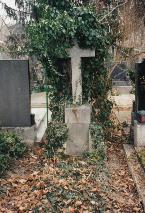Romako, Anton |
| PAINTER (AUSTRIA) |
|
BORN 20 Oct 1832, Wien: Atzgersdorf - DIED 8 Mar 1889, Wien: Heumarkt 11 CAUSE OF DEATH shrinking of the kidney GRAVE LOCATION Wien: Zentralfriedhof, Simmeringer Hauptstraße 234, Simmering (Gruppe 41 F, Reihe 02, Nummer 15) |
|
Anton Romako was the son of the cotton manufacturer Jozef Lepper and his working-manager Elisabeth Romako (22/08/1805-1835). After the death of both his parents in 1835 he was raised by an aunt. He studied at the Academy in Vienna, where Ferdinand Georg Waldmüller observed that he had no talent at all. He continued his studies in Munich with Wilhelm Kaulbach. In 1850 he returned to Vienna where Carl Rahl was his teacher. After a quarrel with Rahl in 1853 he left for Venice in 1854 and lived there until 1855. In Venice he befriended Ludwig Passini. From 1857 onwards he worked as a painter in Rome. On June 11 in Rome, 1862 he married Sophie Köbel, the attractive daughter of the architect Karl Köbel and a woman from Rome. Franz Liszt was present at the marriage ceremony (but he didn't play the piano). They marriage resulted in five children. Romako lived in Rome for nearly twenty years and his work became very popular with the resident colony of foreigners. After his wife eloped with her lover Max bon Dönniges in 1875 they separated (although they never divorced) and he returned to Vienna in 1876. Unfortunately he was less than successful there because Makart's portraits were now preferred above his. He often travelled away from Vienna. His drawing "Tegetthoff in der Schlacht bei Lissa" (1877) was bought by Archduke Ludwig Viktor, but his financial situation became increasingly problematic. In 1880 emperor Franz Joseph bought his painting "Battle of the Amazons" that is now lost. After an auction in his studio in Döbling on 9 August 1882 failed to solve his financial problems he left Vienna for Geneva. After Makart's death in 1884 he returned to Vienna once more. But things got worse when in 1887 his two youngest daughters committed suicide together with the architect Alceste Armoni. Romako didn´t recover from this blow. He died impoverished in 1889 and it would take fifteen years before the world showed any interest in his work again. Because of the uneasiness that speaks from his paintings he is now regarded as a precursor of expressionism. Work: "Kaiserin Elisabeth" (1883, Belvedere, Vienna); "Portrait of Mathilde Stern" (1886, Belvedere, Vienna); "Dame und Herr in Salon" (1887, Historisches Museum der Stadt Wien); "Der Einzug Marc Aurels in Wien" (c.1888, Historisches Museum der Stadt Wien). Related persons • painted Elisabeth von Bayern, Kaiserin von Österreich • worked for Kaulbach, Wilhelm von • influenced Kokoschka, Oskar • knew Liszt, Franz • was pupil of Rahl, Carl |
Sources • Budig, Robert S. et al, Ehrengräber am Wiener Zentralfriedhof, Compress Verlag Wien, Wien • Der Aussenseiter Anton Romako, Österreichische Galerie Wien, Wien, 1992 • Becker, Edwin & Sabine Grabner (eds.), Wenen 1900, Portret en interieur, Van Goghmuseum, Amsterdam, 1997 • Anton Romako - Wikipedia (DE) |






